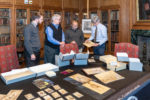 The University of Michigan’s William L. Clements Library has acquired a collection of more than 1,000 rare Native American photographs. The photographs represent 80 indigenous groups and include stereographic images, cartes de visites and government-sponsored portraits. Many of them have never been published before, and even the ones that have are exceptional versions. A picture of Geronimo with members of family shortly before their surrender to the US Army in 1886, for example, was printed straight from the original negative.
The University of Michigan’s William L. Clements Library has acquired a collection of more than 1,000 rare Native American photographs. The photographs represent 80 indigenous groups and include stereographic images, cartes de visites and government-sponsored portraits. Many of them have never been published before, and even the ones that have are exceptional versions. A picture of Geronimo with members of family shortly before their surrender to the US Army in 1886, for example, was printed straight from the original negative.
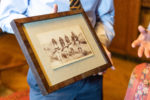 The collection was acquired from Richard Pohrt ,Jr., an art dealer whose father, Michigan-born Richard Pohrt had begun collecting Native American artifacts while still a teenager, eventually amassing one of the largest known private collections which he exhibited in his own small museum in Cross Village, Michigan. As a young man, the senior Pohrt had worked for years on the Fort Belknap reservation and
The collection was acquired from Richard Pohrt ,Jr., an art dealer whose father, Michigan-born Richard Pohrt had begun collecting Native American artifacts while still a teenager, eventually amassing one of the largest known private collections which he exhibited in his own small museum in Cross Village, Michigan. As a young man, the senior Pohrt had worked for years on the Fort Belknap reservation and 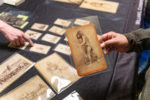 struck up friendships with local people who gifted him with artifacts and oral histories that Pohrt documented assiduously. His son followed in his footsteps and has been collecting Native American objects and photographs for 40 years. The photographs newly acquired by the Clements Library are also exceptionally well-labelled, a rarity in Native American history.
struck up friendships with local people who gifted him with artifacts and oral histories that Pohrt documented assiduously. His son followed in his footsteps and has been collecting Native American objects and photographs for 40 years. The photographs newly acquired by the Clements Library are also exceptionally well-labelled, a rarity in Native American history.
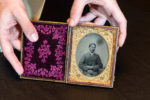 Most of them date to between 1860 and 1920, a period of enormous dislocation and devastation to the country’s indigenous peoples as the 1848 California Gold Rush launched an influx of settlers in the west that only picked up speed after the Civil War. Native Americans were forced onto reservations and fought against the US military for decades in a sequence of wars of rebellions that came to a final end only with the Apache Wars in 1924.
Most of them date to between 1860 and 1920, a period of enormous dislocation and devastation to the country’s indigenous peoples as the 1848 California Gold Rush launched an influx of settlers in the west that only picked up speed after the Civil War. Native Americans were forced onto reservations and fought against the US military for decades in a sequence of wars of rebellions that came to a final end only with the Apache Wars in 1924.
According to Clayton Lewis, curator of graphics material at the Clements, this era also coincides with many of the darkest phases of Native American history, especially in the West.
“The violence, impoverishment, disempowerment and forced cultural assimilation related to United States Indian removal policies and the establishment of reservations and boarding schools are among the major themes represented by these photographs,” he said. “However, the cultural complexity of the communities, the quality of the material culture, the dignity and resilience of leaders, and aspects of rituals and everyday life are also well documented in the Pohrt Collection.” […]
Lewis says that while they are excited about the new acquisition, they are also aware of many of the issues related to the access and display of the culturally sensitive images, which is why they have consulted with several Native American scholars and cultural representatives, as well as the U-M’s Native American Graves Protection and Repatriation Act representative.
“This collection is already so extraordinarily rich because of all of the information that comes with it—names, times, dates and places where the photos were taken—as well as Richard’s expertise in Native American art and material culture,” he said. “The advisers that we’ve been working with are providing even more information and guidance about their context, which will make it a one-of-a-kind resource for both scholars and for Native American people looking to reconnect with their past.”
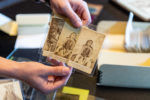 Reconnecting with their past has even greater significance for Native Americans, not only because so many of their traditions were deliberately eradicated, but because Federal recognition laws require that tribes prove they have been a continuous community without gaps. That’s a damned high bar for the US government to set considering it worked tirelessly since literally the first days of its existence to strip Native Americans of their ancestral lands, cultural identities, familial and tribal bonds. So when Eric Hemenway, director of archives and records for the Little Traverse Bay Bands of Odawa Indians who is working with the Clements Library researchers on interpretation and documentation of the photographs, found a picture of his ancestor Viola Assinaway, it wasn’t just a meaningful and moving encounter with his family history, but visual evidence of his tribe’s continuous existence and his place in it.
Reconnecting with their past has even greater significance for Native Americans, not only because so many of their traditions were deliberately eradicated, but because Federal recognition laws require that tribes prove they have been a continuous community without gaps. That’s a damned high bar for the US government to set considering it worked tirelessly since literally the first days of its existence to strip Native Americans of their ancestral lands, cultural identities, familial and tribal bonds. So when Eric Hemenway, director of archives and records for the Little Traverse Bay Bands of Odawa Indians who is working with the Clements Library researchers on interpretation and documentation of the photographs, found a picture of his ancestor Viola Assinaway, it wasn’t just a meaningful and moving encounter with his family history, but visual evidence of his tribe’s continuous existence and his place in it.
The collection will be digitized to give scholars and the general public access to these rare documents. Culturally sensitive images, such as photographs of sacred ceremonies, will not be published online, although some will likely be made available in person at the library.